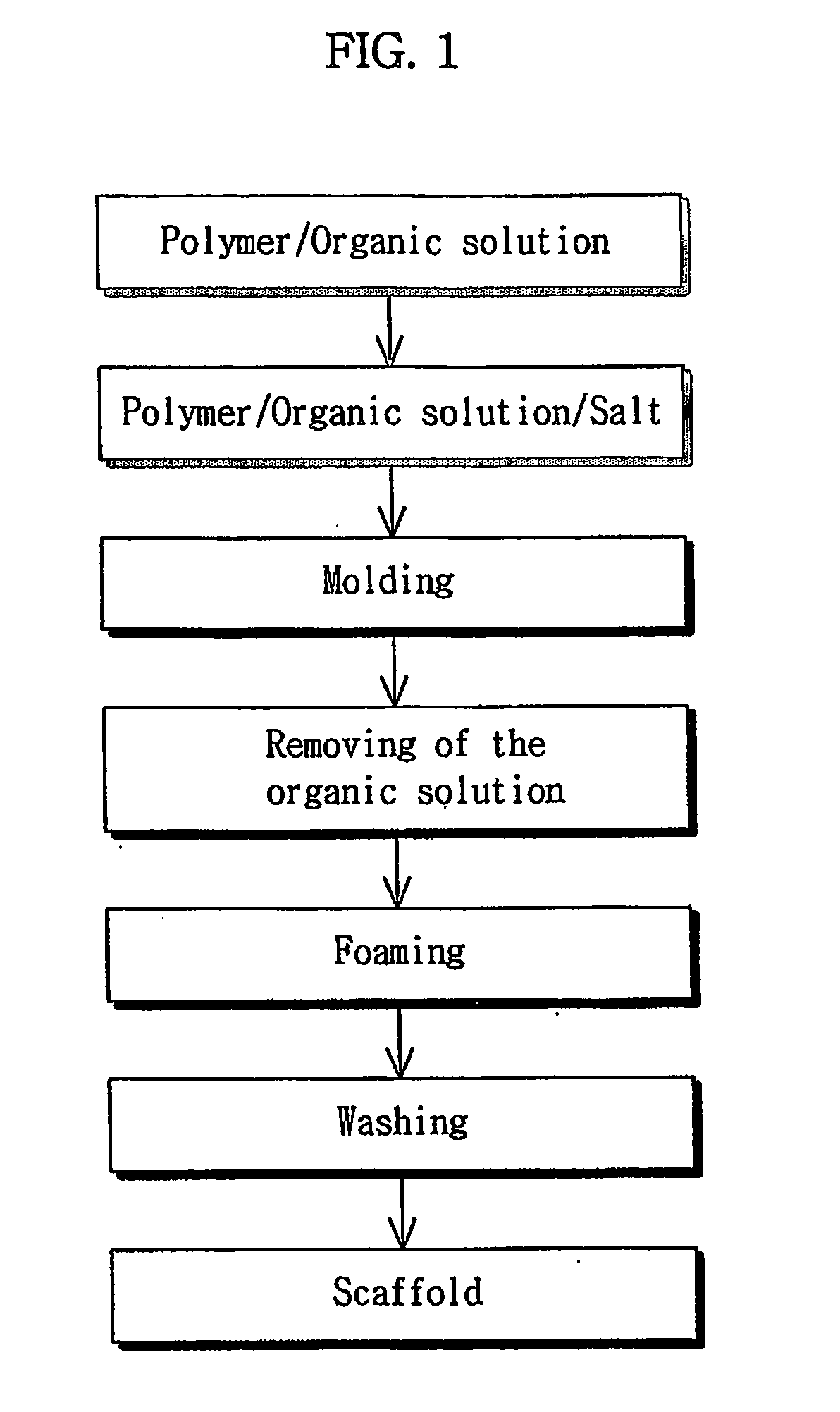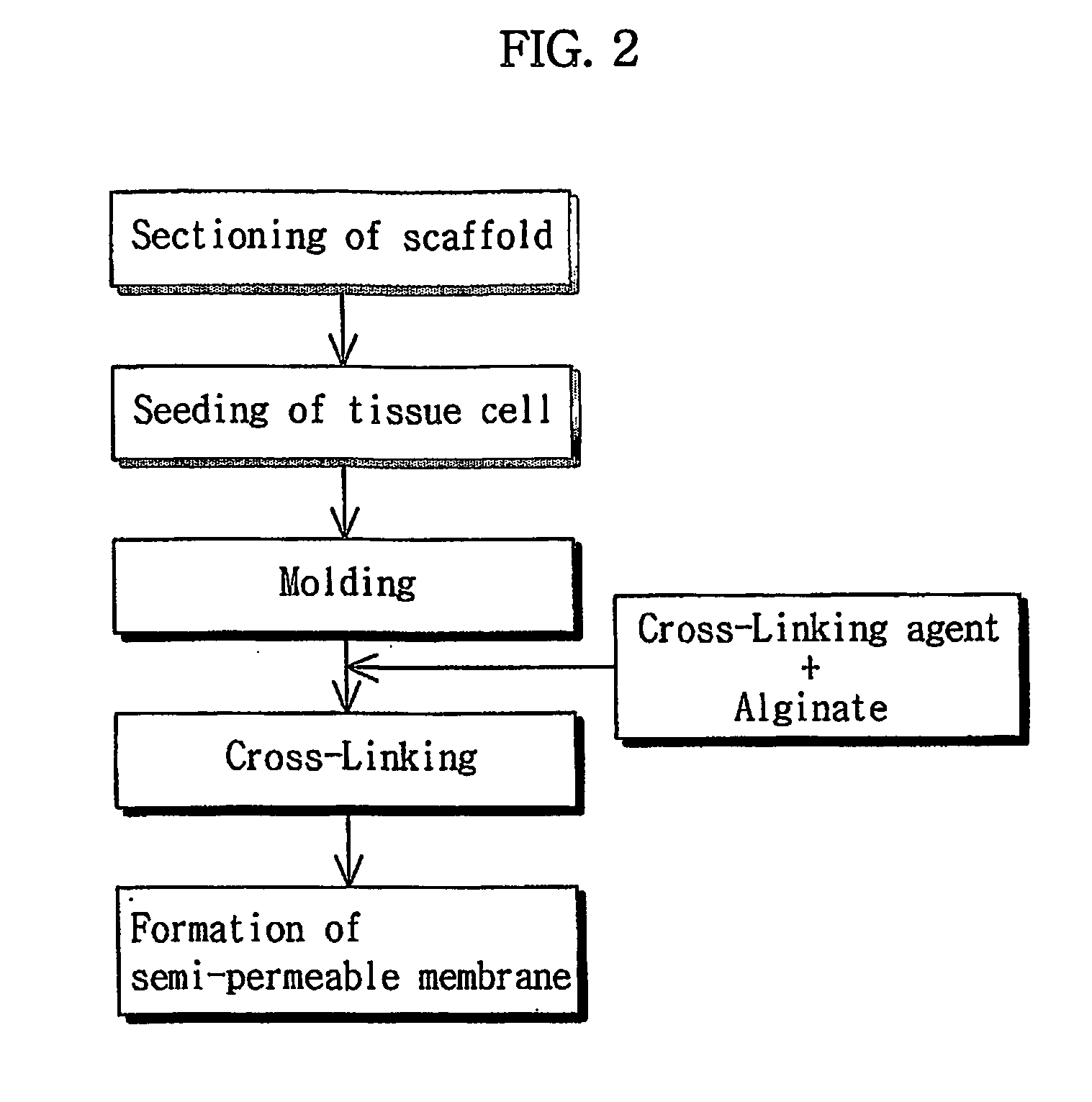Biodegradable dual porous scaffold wrapped with semi-permeable membrane and tissue cell culture using thereof
a biodegradable, semi-permeable membrane technology, applied in the direction of prosthesis, biomass after-treatment, bandages, etc., can solve the problems of scaffolds with relatively low porosities, uncontrollable pore size, and non-absorbable cartilage substitutes used up to date that develop various side effects and complications
- Summary
- Abstract
- Description
- Claims
- Application Information
AI Technical Summary
Benefits of technology
Problems solved by technology
Method used
Image
Examples
example 1
Scaffold Fabrication
[0082] A mixture solvent was prepared by mixing 90% of methylchloride (Ducksan Chemical Co. Ltd., Korea) and 10% of dimethylsulfoxide (Sigma, USA). 10% of PLGA, based on the weight of the mixture solvent, which was composed of lactic acid (Sigma, USA) and glycolic acid (Sigma, USA) at a weight ratio of 75:25, molecular weight of 90,000 to 126,000 Da, was dissolved in the mixture solvent.
[0083] The resulting solution was mixed with ammonium hydrogen carbonate (Junsei Chemical Co. Ltd., Japan) having a particle size of 150-250 μm at a weight ratio of 9:1. The resulting mixture was poured into a cylinder-type schale in size of 100 mm in diameter (Dongsung science Co. Ltd, Korea).
[0084] The methylchloride (Ducksan Chemical Co. Ltd., Korea) contained in the mixture filled into the schale (Dongsung Science Co. Ltd, Korea) was partially evaporated, thus generating a semi-solidified sample.
[0085] Thereafter, the semi-solidified sample was immersed in 30% acetic acid ...
example 2
Regeneration of a Biological Tissue
(i) Seeding of Tissue Cells Onto the Scaffold
[0090] The scaffold prepared in Example 1 was sectioned into pieces at the size of 2 mm in diameter and 1 mm thick. Chondrocytes isolated from rabbits were seeded onto the scaffold pieces at a density of 1.0×106 cells / ml.
[0091] The scaffold pieces were incubated at 37° C. in high humidity containing 5% concentration of CO2 for about three hours to allow for cross-linking of the scaffold pieces. Then, they were incubated for three days in DMEM (JBI, Korea) containing 4 ml of an antibiotic / antifungal solution and FBS (Sigma, USA).
(ii) Formation of a Semi-permeable Membrane on an Outer Surface of the Scaffold and Proliferation of the Tissue Cells.
[0092] A 3% sodium alginic acid solution (Sigma, USA) was mixed with an equal volume of DMEM (JBI, Korea) containing 4 ml of an antibiotic / antifungal solution and FBS (Sigma, USA).
[0093] The resulting mixed solution was put into a 50-ml tube (Nunc, USA) con...
experimental examples
Evaluation of Cell Proliferation
[0096] The gel beads prepared in Example 3 were incubated at 37° C. in high humidity containing 5% CO2 with 90 rpm of shaker's agitation. The culture medium was replaced by a fresh one every three or four days. On Days 7, 14, 21 and 31, to evaluate chondrocyte proliferation, the gel beads were observed under a scanning electron microscope (S-800, Hitachi, Japan), and while a quantitative DNA assay was measured by fluorescence using a luminescence spectrometer (Luminescence Spectrometer LS50B, PERKIN ELMER, Great British).
[0097] The results are given in FIGS. 6, 7 and 8.
[0098]FIG. 6 shows SEM images showing chondrocytes that have been proliferated on the scaffold having a semi-permeable membrane on an outer surface thereof according to the present invention. FIG. 7 is a graph showing DNA synthesis of chondrocytes grown on the scaffold according to the present invention. FIG. 8 is a graph showing glycosaminoglycan synthesis of chondrocytes grown on ...
PUM
| Property | Measurement | Unit |
|---|---|---|
| Size | aaaaa | aaaaa |
| Size | aaaaa | aaaaa |
| Biological properties | aaaaa | aaaaa |
Abstract
Description
Claims
Application Information
 Login to View More
Login to View More - R&D
- Intellectual Property
- Life Sciences
- Materials
- Tech Scout
- Unparalleled Data Quality
- Higher Quality Content
- 60% Fewer Hallucinations
Browse by: Latest US Patents, China's latest patents, Technical Efficacy Thesaurus, Application Domain, Technology Topic, Popular Technical Reports.
© 2025 PatSnap. All rights reserved.Legal|Privacy policy|Modern Slavery Act Transparency Statement|Sitemap|About US| Contact US: help@patsnap.com



